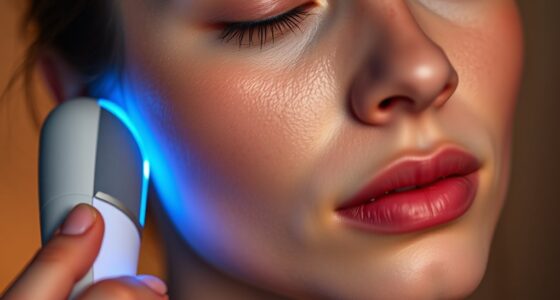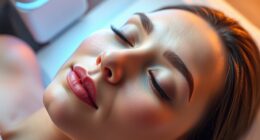Light therapy is a scientifically supported way to improve scalp health by reducing inflammation, increasing blood flow, and stimulating cellular activity. It can promote healing and support follicle vitality, which benefits overall hair health. While it’s not a quick fix or a cure for genetic hair loss, consistent use can create a healthier scalp environment. If you want to learn how this therapy can truly benefit your scalp and hair, keep exploring the facts behind the science.
Key Takeaways
- Light therapy uses specific wavelengths to stimulate cellular activity, improving scalp health and reducing inflammation.
- It promotes blood flow, delivering essential nutrients to hair follicles and supporting overall scalp vitality.
- Light therapy is a safe, non-invasive treatment that complements scalp hygiene and nutrition for better results.
- It helps calm inflammatory scalp conditions like dermatitis and psoriasis, fostering a healthier environment for hair growth.
- While effective for scalp health, light therapy isn’t a cure for hereditary baldness but supports follicle wellness.

Have you ever considered how light therapy might improve your scalp health? If you’ve heard about its potential benefits for hair growth, you might think it’s just another fad or a miracle cure. But beyond the myths, light therapy offers scientifically supported advantages that could help you address scalp issues like inflammation, poor circulation, and even certain types of hair loss. This non-invasive treatment uses specific wavelengths of light, usually red or near-infrared, to penetrate the skin and stimulate cellular activity. When applied regularly, it can boost blood flow, encourage healing, and reduce inflammation, all of which are essential for maintaining a healthy scalp environment.
One reason light therapy is gaining popularity is that it targets underlying problems rather than just masking symptoms. For example, if your scalp is inflamed or irritated due to conditions like seborrheic dermatitis or psoriasis, light therapy can help calm the inflammation and promote healing. It works by reducing the production of inflammatory chemicals, which in turn alleviates discomfort and prevents further damage. Additionally, improved blood flow from the therapy delivers more oxygen and nutrients to your hair follicles, supporting their health and vitality. This process can be especially beneficial if you’re experiencing thinning hair, as a healthier scalp provides a stronger foundation for growth.
While some people assume that light therapy will instantly restore thick, luscious hair, the reality is that it’s a gradual process. Consistency is key, and results may take several weeks or months before becoming noticeable. It’s also important to understand that light therapy isn’t a cure-all. It works best when combined with other healthy scalp practices, such as proper cleansing, balanced nutrition, and avoiding harsh chemicals. If your hair loss stems from genetic factors, light therapy can still support follicle health and slow progression, but it won’t reverse hereditary baldness entirely. Moreover, understanding the science behind light therapy can help you make informed decisions about its use and expected outcomes.
You might worry about safety or side effects, but light therapy is generally safe when used correctly. Unlike medications or invasive procedures, it doesn’t involve chemicals or surgical risks. However, you should follow manufacturer instructions or consult a healthcare professional to ensure appropriate use. Overexposure or improper application can cause minor side effects like scalp dryness or slight discomfort, but these are usually temporary. Ultimately, understanding the science behind light therapy helps you see it as a legitimate option rather than just a trendy treatment. By approaching it with realistic expectations and consistent use, you can harness its potential to promote a healthier scalp and, in turn, healthier hair.
Frequently Asked Questions
Can Light Therapy Improve Scalp Conditions Other Than Hair Loss?
Yes, light therapy can improve scalp conditions beyond hair loss. It helps reduce inflammation, soothe irritation, and promote healing of scalp issues like dandruff, psoriasis, or dermatitis. By stimulating blood flow and encouraging cell regeneration, you may notice a healthier scalp and less discomfort. Regular treatments can enhance scalp health, making it easier for your hair to grow and stay strong.
Are There Any Age Restrictions for Using Scalp Light Therapy?
Yes, there are age restrictions for using scalp light therapy. If you’re a child, your doctor should evaluate if it’s safe, as their scalp and skin are more sensitive. Adults, including seniors, generally can benefit from the treatment, but it’s crucial to consult a healthcare professional first. Always prioritize professional advice to ensure the therapy suits your age, health, and specific scalp conditions.
How Long Does It Typically Take to See Results From Light Therapy?
You’ll usually start noticing results from scalp light therapy within 8 to 16 weeks of consistent use. The exact timeline depends on factors like your scalp condition, the frequency of treatments, and individual response. To maximize benefits, stick to your recommended schedule, and be patient. Keep in mind that some people see improvements sooner, while others may need a bit more time for visible changes.
Is Light Therapy Safe for People With Sensitive Skin?
If you have sensitive skin, light therapy can be safe, but caution is key. Studies show that over 80% of users with sensitive skin experience minimal irritation when using proper equipment and following guidelines. You should start with shorter sessions and use devices designed for sensitive skin types. Consulting a dermatologist first helps guarantee safe and effective treatment, making it a viable option without risking adverse reactions.
Can Light Therapy Be Combined With Topical Scalp Treatments?
Yes, you can combine light therapy with topical scalp treatments. Just make sure to apply your treatments after your light therapy sessions or as recommended by your dermatologist. This approach can enhance the effectiveness of both therapies, but it’s important to consult with your healthcare provider beforehand. They can advise you on the best timing and products to use together, ensuring safety and ideal results for your scalp health.
Conclusion
Now that you know how light therapy can boost your scalp health, you’re better equipped to make informed choices. Think of it as a gentle sunrise, gradually awakening your scalp’s natural vigor. While it’s not a magic wand, consistent use can help improve your hair’s strength and overall scalp condition. Embrace this innovative approach and give your scalp the nourishing attention it deserves—like tending to a garden that blooms with health.









